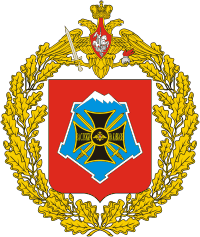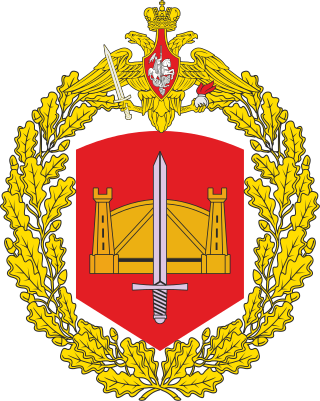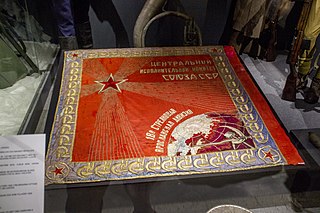A mechanised corps was a Soviet armoured formation used prior to the beginning of World War II and reintroduced during the war, in 1942.

The Leningrad Military District is a military district of the Armed Forces of the Russian Federation. In 2010 it was merged with the Moscow Military District, the Northern Fleet and the Baltic Fleet to form the new Western Military District. In December 2022, Defense Minister Sergey Shoigu proposed to reestablish it along with the Moscow Military District, a decision confirmed in June 2023 by Deputy Chief of the General Staff Yevgeny Burdinsky. On December 17, 2023 Vladimir Putin announced plans to recreate the Leningrad Military District as a reaction to Finland joining NATO. The district was formally reconstituted on February 26, 2024 by a Presidential Decree.
The 216th Rifle Division was a division of the Red Army and Soviet Ground Forces. It was the successor to a motorized division of that same number that was destroyed during the Battle of Uman in August 1941. It fought at Kharkov and in Karelia, Crimea, and Kurland.

The North Caucasus Military District was a military district of the Russian Armed Forces from 1992-2010. Before 1992 it had been part of the Soviet Armed Forces since 1918. In 2010 it became the Southern Military District and lately also included the Black Sea Fleet and Caspian Flotilla.

The 90th Guards Tank Division was a division of the Soviet Army, and then of the Russian Ground Forces.

The 58th Guards Combined Arms Army is an army of the Russian Ground Forces, headquartered at Vladikavkaz, North Ossetia-Alania, within Russia's Southern Military District. It was formed in 1941 as part of the Soviet Union's Red Army and has been part of the Russian Army since 1995. It has the Military Unit Number (в/ч) is 47084.
The Arkhangelsk Military District was a regional military district of the Red Army which oversaw the North-Western part of the Russian Soviet Federative Socialist Republic. The district was formed in 1940 during a reorganisation of the Army, but disbanded in 1944, reformed two years later, and finally disbanded in 1951.
The 15th Rifle Division was a military formation of the Red Army formed by renaming the Red Army's Inza Revolutionary Division on 30 April 1919. The division was active during the Russian Civil War and World War II.

The 18th Rifle Division was an infantry division of the Soviet Union's Red Army during the Russian Civil War, Polish–Soviet War, Winter War and World War II. The division was formed a total of five times during this period.
The 42nd Army was a field army of the Soviet Union's Red Army, created in 1941.
The 42nd Rifle Division was a unit of the Red Army during the Great Patriotic War. The division, first formed in 1940, was nearly destroyed in the opening days of the Operation Barbarossa defending the Brest Fortress. Disbanded in late December 1941 and immediately reformed in the Volga Military District. The division then served on the front until disbanded at the end of the war.
The 36th Rifle Division was a division of the Red Army and then the Soviet Army. The division was formed in 1919 as the 36th Rifle Division and fought in the Russian Civil War and the Sino-Soviet conflict of 1929. In 1937 it became the 36th Motorized Division. The division fought in the Battles of Khalkhin Gol. It was converted into a motor rifle division in 1940 and fought in the Soviet invasion of Manchuria in World War II. Postwar, it became a rifle division again before its disbandment in 1956. The division spent almost its entire service in the Soviet Far East.
The 207th Rifle Division began its combat path under unusual circumstances. It was partly formed for the first time as a standard Red Army rifle division in the spring of 1941, before the German invasion, but was never completed. A second formation began in April 1942 and was completed on June 1, after which it was sent to the Stalingrad Front. Heavily depleted in counterattacks against the north flank of German Sixth Army, by November the survivors were reassigned and the division disbanded. The 207th was formed for a third time in June 1943, and fought its way through the central part of the Soviet-German front, ending the war in the heart of Berlin in the battle for the Reichstag. The division saw postwar service in the Group of Soviet Forces in Germany.
The 40th Rifle Division was an infantry division of the Red Army during World War II. It gained the honorific "named for Sergo Ordzhonikidze" on 14 April 1937. It fought in the engagements at Lake Khasan. On 22 June 1941, it was part of the 39th Rifle Corps, 25th Army, in the Far East Military District. The division fought in the Soviet invasion of Manchuria in 1945. In 1957, it was converted into a motorized rifle division. From 1957 to 1989 it was based at Smolyaninovo-1, Primorskiy Krai. In 1989 it was transferred to the Pacific Fleet as a coastal defence division. It was disbanded in 1996.
The 111th Tank Division was a Tank division of the Soviet Union's Red Army and after 1946, the Soviet Army. The division was formed in the summer of 1941 in the Soviet Far East from the tank regiment of a motorized division that had been reorganized into a motor rifle division, and had thus lost its tank regiment. The division never fought in combat and was in reserve during the Soviet invasion of Manchuria. Postwar, the division continued its garrison duty in the Far East. The 111th was renumbered as the 16th Tank Division in 1955.
The 109th Motorized Division was formed from the 109th Rifle Division in January, 1940, in the Transbaikal Military District. It was one of the first Red Army mechanized divisions formed and also one of the first to be fully equipped with motor vehicles and tanks. Shortly before the German invasion, in late May, 1941, it began moving west by rail, arriving in western Ukraine on June 18. The division went into action on June 26, but by early July had lost most of its tanks and trucks. It was soon pulled back into the reserves of Southwestern Front and converted into the 304th Rifle Division.
The 1st Tank Division was a Division sized unit of the Red Army that existed from 1940–42. It was later reformed, from a separate formation, with a different lineage. Within the Soviet Ground Forces it existed as a second line ready division from 1945–2008, at Kaliningrad in the Baltic Military District.
The 213th Rifle Division was formed as an infantry division of the Red Army during World War II after a motorized division of that same number was destroyed about seven weeks following the start of the German invasion of the Soviet Union.
The 60th Mountain Rifle Division was formed as a specialized infantry division of the Red Army in the spring of 1941, based on the 60th "Caucasian" Rifle Division which traced its origins back to just after the Russian Civil War. At the time of the German invasion on 22 June 1941 it was located in the foothills of the Carpathian Mountains near the border with Hungary as part of the 17th Rifle Corps of 12th Army in the Kiev Special Military District. While the division was not attacked by the main German forces in the first days, its almost total lack of trucks and shortage of horses made it difficult to retreat to the east. It was soon transferred with 17th Corps to the new 18th Army in Southern Front, but returned to 12th Army in mid-July. It fell back through western Ukraine under that headquarters into August when it found itself encircled in the Uman pocket where all but remnants of the division were destroyed. The 60th Mountain was finally officially disbanded on 19 September 1941.
The 72nd Mountain Rifle Division was formed as a specialized infantry division of the Red Army in the spring of 1941, based on the 72nd Rifle Division which had previously been the 4th Turkestan Division. At the time of the German invasion on June 22 it was located on the San River west of Lviv as part of the 8th Rifle Corps of 26th Army in the Kiev Special Military District. After having about half of its complement removed to Army reserves or transferred to other divisions it was forced to fall back through western Ukraine under pressure from the German 17th Army until early August when it was encircled as part of 12th Army near Uman. After about five more days of fighting the 72nd Mountain had been effectively destroyed and it was officially disbanded a month later. It was never reformed.






